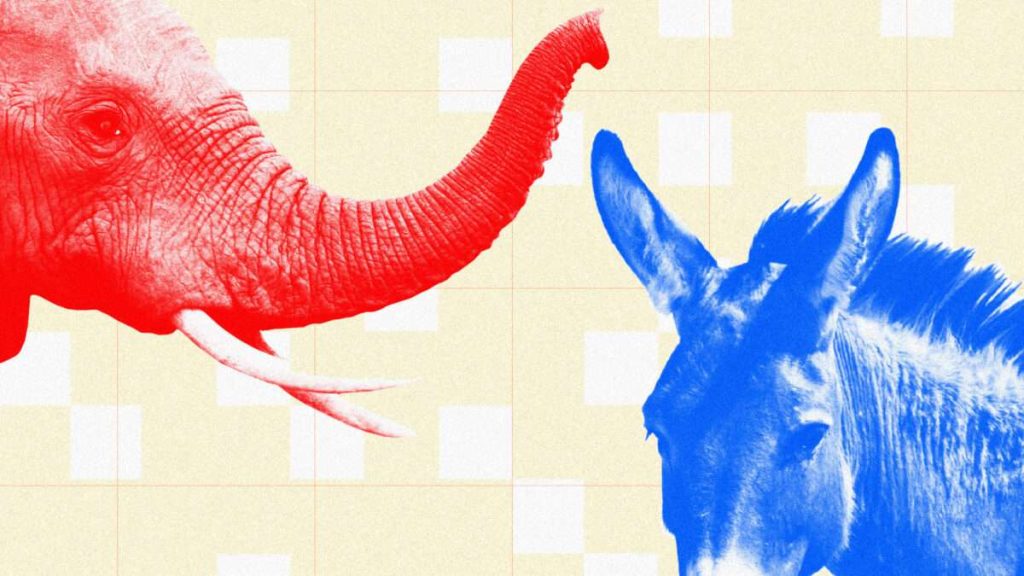For those seeking balance in this polarized moment in American politics, Gallup offers news that initially seems good. The polling firm finds Americans are becoming increasingly socially liberal while generally remaining economically conservative. Using a crude definition of libertarian and classical liberal ideas, growing social liberalism paired with economic conservatism sounds encouraging. But the ideological shift is all one-sided, with Democrats moving left much more than Republicans moved to the right—threatening not balance, but a wider partisan divide.
Socially Liberal and Economically Conservative
“Americans have become significantly more likely to identify as liberal in their views on social issues over the past quarter century,” Gallup noted earlier this month. “Meanwhile, Americans still lean conservative on economic issues, but the percentage leaning liberal has been trending up slightly.”
Whether or not you support specific changes in public opinion, mass ideological shifts are always at least interesting, with potential ramifications for policy and culture. Could these trends help to heal the partisan wounds of recent years? I wouldn’t bet on it.
“Both trends toward more liberal views than in the past are driven by U.S. Democrats; neither Republicans nor independents have become more liberal in their views over time,” Gallup adds.
…or Just Conservative Republicans and Really Liberal Democrats
Specifically, in 2004, 39 percent of Democrats described their views on social issues as “liberal/very liberal”; in 2024, 69 percent of Democrats describe themselves that way. Four percent of Republicans and 28 percent of independents called themselves “liberal/very liberal” on social issues in 2004, with 3 percent of Republicans and 28 percent of Independents describing themselves that way this year.
Over that time, on social issues, the share of Americans calling themselves “conservative/very conservative” went from 64 percent of Republicans, 24 percent of Independents, and 20 percent of Democrats to 74 percent of Republicans, 23 percent of Independents, and 6 percent of Democrats.
In 2004, 28 percent of Democrats said they were “liberal/very liberal” on economics, which grew to 49 percent in 2024. For Republicans, the number went from 5 percent to 3 percent, and for Independents, from 16 percent to 18 percent.
The ranks of those describing themselves as “conservative/very conservative” on economic issues went from 64 percent of Republicans, 36 percent of Independents, and 26 percent of Democrats to 82 percent of Republicans, 35 percent of Independents, and 5 percent of Democrats.
“Americans” as a whole aren’t becoming more liberal on social and economic issues. Independents haven’t budged (a plurality are moderate), Republicans are shifting conservative, and Democrats are sliding liberal strongly enough to move the national average—or are describing themselves that way.
These numbers are all based on self-description, not specific positions on trade, abortion, drugs, or regulation. Twenty years ago, “economically conservative” probably meant free markets, low taxes, and cutting red tape. “Socially liberal” could have been interpreted as pro-choice on abortion, tolerant of marijuana, and supportive of civil liberties. In our ideologically messy year of 2024, the Republican party is protectionist and more supportive of state guidance of the economy. Democrats have adopted identitarian concerns and elevated controlling “disinformation” over protecting free speech. Republicans and Democrats describe themselves in increasingly stark contrast, but their reference points for “liberal” and “conservative” might be different than in the past.
Disagreement on Specific Issues Emphasizes the Divide
Interestingly, progressive blogger Kevin Drum looked at the data on support for specific issues in 2021 and also concluded that, while Republicans had shifted right, Democrats had gone left much harder.
“Progressives have been bragging publicly about pushing the Democratic Party leftward since at least 2004—and they’ve succeeded,” he wrote. “Democrats have been moving further and further away from the median voter for years.”
On issues including immigration, abortion, same-sex marriage, guns, and taxes, he found Democrats drifting strongly towards the liberal position, while Republicans shifted a bit more conservative—or not.
“Among Republicans, the most extreme view on abortion (always illegal) has gone up by about two points since 2000. Among Democrats, the most extreme view (always legal) has gone up by 20 points,” he noted. Both Democrats and Republicans strongly increased support for same-sex marriage.
“Over the past two decades Democrats have moved left far more than Republicans have moved right,” Drum concluded. He voiced personal satisfaction with a Democratic party drifting closer to his preferred progressive positions but emphasized that this came with a price: “It is not conservatives who have turned American politics into a culture war battle. It is liberals.”
Different issues might produce somewhat different results. But Drum’s analysis of specific points of political disagreement corresponds closely to shifting ideological self-identification.
It’s Also a Battle of the Sexes
Interestingly, that growing divide between Democrats and Republicans parallels findings in an article in January by John Burn-Murdoch of the Financial Times. He noted ideological shifts in many countries among young men and women.
“The trend in most countries has been one of women shifting left while men stand still,” wrote Burn-Murdoch. “In the US,…women aged 18 to 30 are now 30 percentage points more liberal than their male contemporaries.” By contrast, American men are tending center to center-right in stated ideology and positions on issues.
That could be…interesting, for partisan political contests in the future. As if relations between the sexes weren’t already sufficiently fraught.
For people looking for a peaceful resolution to this country’s political warfare, and for libertarians seeking a home, there’s not much encouragement here. The data suggests the division between the two dominant political parties is deepening, with Democrats drifting ever further to the left. That magic convergence of economic liberty and social freedom has yet to capture either of the major parties.
The widening ideological gap and the challenge of finding political solutions that can bridge that division leaves us living in interesting times. Of course, living in such times has been described as a curse.
The post Democrats’ Political Views Are Shifting Faster Than Republicans’ appeared first on Reason.com.







